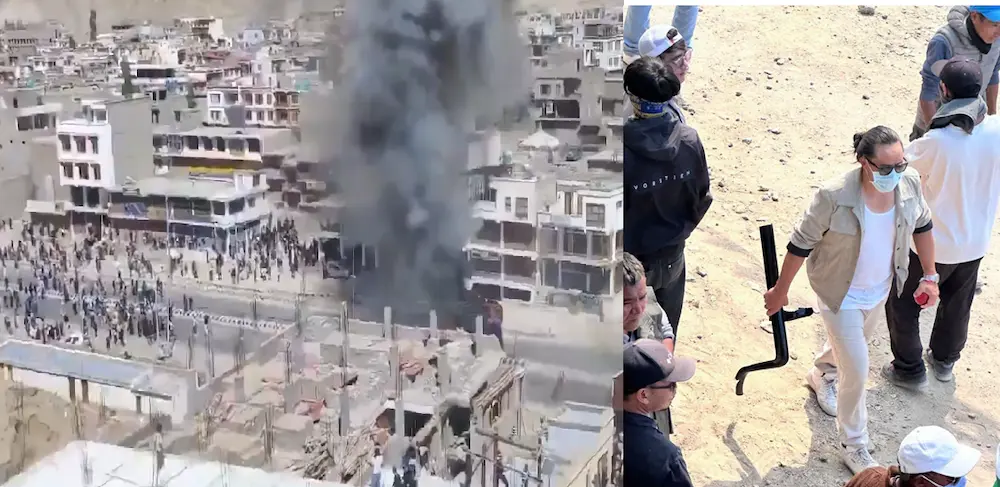
Ladakh’s statehood protest erupts in violence with stone pelting and arson let by Congress Councillor, Phuntsog Stanzin Tsepag
Why Ladakh’s Peaceful Protest Exploded into Violent Stone Pelting
Ladakh Cries for Statehood Turns Violent – Ladakh, the land of high passes and serene landscapes, is known for its calm and spiritual energy. But on a recent Wednesday, the silence of Leh city was shattered by angry chants, smoke rising from burning buildings, and stones flying through the air. What began as a peaceful hunger strike and shutdown demanding statehood and constitutional rights turned into a violent clash between protesters and police.
The protest was led by the youth wing of the Leh Apex Body (LAB), supported by the Kargil Democratic Alliance (KDA), and joined by climate activist Sonam Wangchuk. Their demands were clear: Ladakh should be granted statehood and included under the Sixth Schedule of the Indian Constitution, which provides special protections and autonomy to tribal regions. But when two hunger strikers were hospitalized due to deteriorating health, emotions boiled over, and the streets of Leh erupted in unrest.
What Happened: From Hunger Strike to Stone Pelting
The protest had been brewing for weeks. Since September 10, 15 individuals had been on a hunger strike, hoping to pressure the central government into meaningful dialogue. The strike was symbolic—a peaceful way to show the seriousness of their demands. But when two of the strikers were rushed to the hospital, the youth took to the streets in anger.
- Shutdown and March: The LAB youth wing called for a complete shutdown in Leh. Thousands joined the protest, chanting slogans and waving banners.
- Stone Pelting Begins: As tensions rose, some protesters began throwing stones at police officers and government buildings, including the Leh Hill Council office.
- BJP Office Set on Fire: In a shocking turn, the Bharatiya Janata Party (BJP) office in Leh was torched. A police van parked nearby was also set ablaze.
- Police Response: The police responded with teargas shells and baton charges to disperse the crowd. Additional forces were deployed to control the situation.
Sonam Wangchuk, who had been leading the hunger strike, expressed deep disappointment. “My message of peaceful path failed today. I appeal to youth to please stop this nonsense. This only damages our cause,” he said in a video message.
Why Are Ladakhis Demanding Statehood and Sixth Schedule?
To understand the anger, we need to look back at 2019. That year, the Indian government abrogated Article 370, which gave special status to Jammu and Kashmir. The region was split into two Union Territories: Jammu & Kashmir (with a legislature) and Ladakh (without one). Ladakh came under direct central rule, and many locals felt politically voiceless.
- Statehood: Ladakhis want their own elected government and legislative powers. They feel decisions about their land, culture, and future should be made by locals—not distant bureaucrats.
- Sixth Schedule Inclusion: This part of the Constitution gives tribal-majority areas autonomy through district councils. Since over 90% of Ladakh’s population belongs to Scheduled Tribes, activists argue that Ladakh qualifies for this protection.
- Protection of Land and Jobs: Without local governance, many fear that outsiders may buy land or take jobs meant for Ladakhis. The Sixth Schedule would help safeguard these rights.
The central government has formed a committee to examine these demands, and a new round of talks is scheduled for October 6. But protesters say they’ve waited too long, and patience is running thin.
What’s Next: Dialogue, Peace, and the Road Ahead
The violence in Leh has shocked many across India. Ladakhis are known for their peaceful nature, and this sudden eruption of anger is a sign of deep frustration. But what happens next?
- Talks with the Centre: The upcoming meeting between Ladakh representatives and the central government could be a turning point. If the government agrees to some demands, tensions may ease.
- Restoration of Peace: Sonam Wangchuk and other leaders are urging youth to return to peaceful protest. Violence, they say, only weakens their cause.
- Political Impact: With elections approaching, parties may be forced to take a clear stand on Ladakh’s demands. The BJP, whose office was attacked, may face pressure to fulfill its earlier promises.
- Cultural Losses: The unrest also led to the cancellation of the Ladakh Festival’s closing ceremony—a major cultural event. This shows how political tensions can affect even the social and cultural life of the region.
1 thought on “Stones, Smoke, and Silence: Ladakh Cries for Statehood Turns Violent”
Comments are closed.